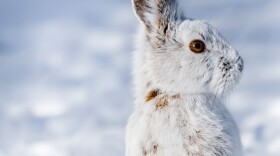I had spent the day in a state of bliss. Despite having to be mindful of the alligators artfully shrouded under mounds of dry grasses along the trails, my visit to the Orlando Wetlands Preserve in central Florida had been nothing short of amazing—a birder’s paradise. It was nesting season for Roseate Spoonbills and Wood Storks. These magnificent birds were gathered in droves, squawking and alighting on their nests, careening with focused intent above the water’s surface. Large flocks of whistling-ducks splashed and preened together. Gallinules, both Purple and Common, foraged among the vegetation at the water’s edge.
Amid the kaleidoscope of colors and shapes, one lone bird stood out vividly. I spotted it as I was heading for the exit, trailing far behind my husband. A lone Sandhill Crane stood at the edge of the marsh feeding, its bill dipping repeatedly through the mud with a series of rapid, steady bursts reminiscent of a sewing machine’s insistent motion. The long neck and legs, along with the red cap crowning a long, dark bill, were unmistakable. The brilliant sunlight that had elicited iridescence from the Purple Gallinule’s plumage worked no such magic on the muted gray of the Sandhill Crane’s feathers. Yet, there was something arrestingly different about this bird. It seemed so comfortable in its solitude, so self-assured. Where did it come from? And where was its family? This Sandhill Crane was far from home, or so I thought.
It turns out that there are multiple subspecies of Sandhill Cranes. Some are year-round residents in Florida, like the individual I chanced upon. Others are migratory, and these subspecies are primarily the subpopulations seen in Montana as they head toward breeding grounds both in our state, and in distant destinations like Canada, Alaska, and even Siberia.
Every subspecies of Sandhill Crane relies on large tracts of land along the edges of water. Loss of foraging grounds, degradation of shallow wetlands needed for roosting, and interrupted flyway connectivity remain potential threats to their survival.
Despite relentless development, however, Sandhill Crane numbers continue to increase. In addition, fossils of Sandhill Cranes date back 2.5 million years. I can only conclude that this enduring success is largely based on how these birds have adapted to manage their energy resources and protect each other. Over time, Sandhill Cranes have evolved to be omnivorous. They eat whatever is available, consuming plant matter, seeds and grains, vertebrates and invertebrates. To conserve energy needed for long migrations, Sandhill Cranes have developed a slow, powerful wingbeat and use thermals to obtain lift. They can soar for hours riding these warm currents of air with little exertion.
Sandhill Cranes have also developed an arsenal of responses to protect each other. They mate for life, working together to build nests and raise chicks. In defending their offspring, they will fight and vocalize aggressively, using that strong, sewing machine-like motion of their serrated bill to attack so vigorously, it can break the skull of their opponent. For their first fall migration, the new family will travel within a large flock, gaining protection in numbers and teaching their fledglings the migratory route. Sandhill Cranes roost in large numbers, standing in shallow bodies of water where the sound of splashing announces potential predators.
Several years ago, I heard the distant trumpeting calls of Sandhill Cranes while hiking in Yellowstone National Park, but was not able to observe them. It was almost ironic to stumble upon one, unwittingly, while trekking through central Florida. Maybe that was part of what caught my attention when I came upon that isolated bird. Its lone presence intrinsically spoke to me of the Sandhill Crane’s immutable resilience. The unique ballad of the Sandhill Crane, whether produced singly or in unison, is likely to be heard for the next 2.5 million years.
Finally, I turned to leave the wetlands, taking with me a pervasive feeling of hope.
Today’s Field Note was written by Irmina Boulier in the Field Notes Writing Workshop at the Montana Natural History Center. This is Allison De Jong for Field Notes, brought to you by the Montana Natural History Center, providing natural history education for schools and the public throughout Montana. To find out about upcoming events and programs at the Center, call 406.327.0405, or visit our website at MontanaNaturalist.org.





